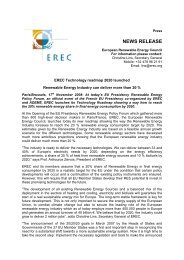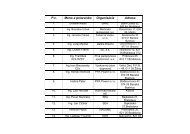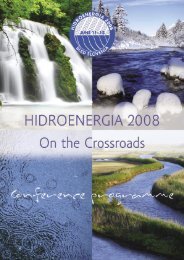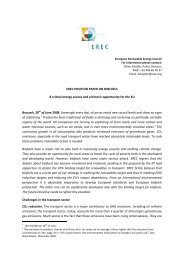Geothermal - European Renewable Energy Council
Geothermal - European Renewable Energy Council
Geothermal - European Renewable Energy Council
You also want an ePaper? Increase the reach of your titles
YUMPU automatically turns print PDFs into web optimized ePapers that Google loves.
<strong>Geothermal</strong> electricity in Europe<br />
As far as geothermal electricity is concerned<br />
the vast majority of eligible resources, in<br />
Continental Europe at large, is concentrated<br />
in Italy, Iceland and Turkey; the presently<br />
exploited potential represents so far 0.3% of the<br />
whole renewable energy market.<br />
There are two major geothermal areas in Italy,<br />
Larderello-Travale/Radicondoli and Monte Amiata<br />
respectively, achieving a 810 MW e<br />
installed<br />
capacity.<br />
They represent two neighbouring parts of the<br />
same deep seated field, spreading over a huge,<br />
ca 400 km 2 , area, which produces superheated<br />
steam. On the Larderello side the exploited area<br />
and installed capacity amount to 250 km 2 and<br />
562 MW e<br />
respectively. On the Travale/Radicondoli<br />
side, to the Southeast, the installed capacity is<br />
160 MW e<br />
and the exploited area 50 km 2 . The<br />
steam condensates recovered from Travale are<br />
reinjected into the core of the Larderello field,<br />
via a 20 km long water pipeline.<br />
The Monte Amiata area, in Northern Latium,<br />
includes two water dominated geothermal fields,<br />
Piancastagnaio and Bagnore. On both fields a deep<br />
resource has been identified under the shallow<br />
producing horizons. Weak social acceptance from<br />
the local communities are slowing down the full<br />
development of the promising, high potential, deep<br />
reservoir. Presently, five units are operating, one in<br />
Bagnore and four in Piancastagnaio, totalling a 88<br />
MWe installed capacity. Projects, adding a further<br />
100 MWe capacity, have been commissioned and<br />
will be completed in the near future.<br />
<strong>Geothermal</strong> resources in Iceland relate to the active<br />
volcanic environment of the island, located on<br />
the mid-Atlantic ridge and its sea floor spreading<br />
attributes. Iceland has proved a leading country<br />
in direct uses of geothermal energy, mainly in<br />
greenhouse and district heating (89% of the total<br />
domestic heating demand) and is increasing its<br />
electricity production which reached (@2006) a<br />
420 MW e<br />
installed capacity. Although significant<br />
this capacity ought to be compared to the huge<br />
potential of the island, estimated at ca 4000 MW e<br />
,<br />
a figure far above national power requirements,<br />
ca 1500 MW e<br />
, among which hydropower holds<br />
the dominant share (1300 MW e<br />
).<br />
Turkey’s geothermal resources are mainly located<br />
in Western Anatolia on the Aegean sea façade.<br />
District heating stands presently as the most<br />
important utilisation with 65000 heated homes.<br />
This, in spite of mild climatic conditions which still<br />
makes geothermal heat competitive as a result<br />
of the high cost of electric heating, 8 to 10 times<br />
higher than geothermal heat. Electricity production<br />
in the Kizildere water dominated field is supplied<br />
by a 15 MW e<br />
design plant (start up, 1988) capacity,<br />
actually standing at 12 MW e<br />
. Binary plants<br />
have been commissioned. The largest geopower<br />
(flashed steam) plant, rated 45 MW e<br />
, is presently<br />
in advanced construction stage, at Germencek.<br />
The geothermal electricity potential has been<br />
(conservatively) estimated at 200-300 MW e<br />
.<br />
In Greece, high temperature geothermal resources<br />
are located in the Aegean volcanic<br />
island arc, in the Milos (Cyclade) and Nisyros<br />
(Dodecanese) islands, thanks to direct drilling<br />
and testing assessments. Electricity generation<br />
from a 2 MW e<br />
rated pilot plant ceased further to<br />
the strong opposition of the local community and<br />
mismanaged communication by the geothermal<br />
operator. The country potential in the Aegean<br />
archipelagos and, at a lesser extent through, in<br />
the northern, mainland located, grabens<br />
is estimated at ca 200 MW e<br />
. Otherwise,<br />
several low temperature fields are<br />
exploited, on presently limited bases,<br />
for greenhouse heating and process<br />
heat applications.<br />
In Russia, geoelectric development took<br />
place in the Mutuovski field of Kamchatka<br />
which, although belonging politically to<br />
Europe, ought to be regarded as geogra-<br />
Iceland<br />
Krafla, Iceland<br />
10 EGEC | <strong>Geothermal</strong> Electricity and Combined Heat & Power


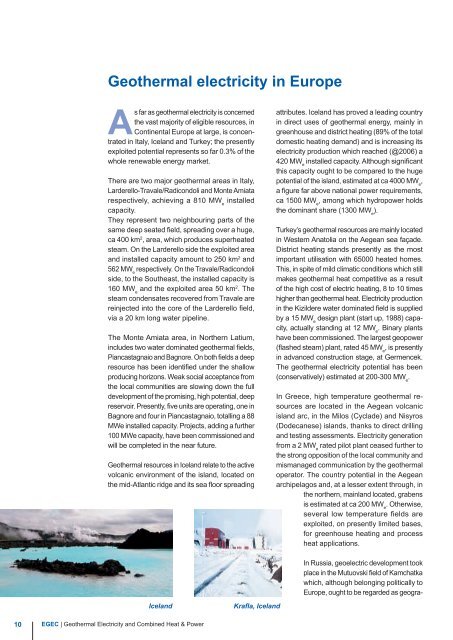

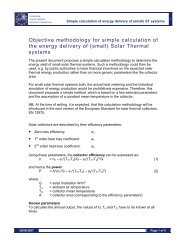

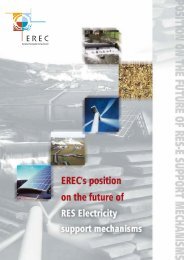

![Energy [R]evolution - Greenpeace](https://img.yumpu.com/47174859/1/184x260/energy-revolution-greenpeace.jpg?quality=85)
